Survey Says!
The results of my survey are completed. I will discuss what they say below. A bit of background first.
To start... I did this survey because I felt we needed to see more data. The Chamber did a great job getting the conversation going. They did a great job getting over 500 responses before their presentation to the BOCC. I have heard they are close to 1000 overall responses. That is great.
The problem I felt was that it asked basic support type questions and did not dive into the specifics of what people will and will not support. I felt that is important information to know, particularly for commissioners who will be making the decision on what to put into it. Voters ultimately decide if it passes or not.
How are commissioners supposed to decide what items to include, how long to do it for and all of that if they don't have the data that shows that, much less know what the community would support? Are they supposed to throw darts and guess?
Again, not a knock on the Chamber's effort. They wanted to see if there was support. But I do not think there is enough data there for commissioners to make an education decision. At the very least, I wanted to show where the community support is on various things.
Mission accomplished.
This survey had 362 responses. I spent about $50 on my own to get this out to more people. I targeted those with 25 miles of Lecanto (34461) and excluded Hernando, Marion, Levy and Sumter Counties. I used a voter demographic if 35 years old and older as they are the most likely voting demographic for the 2026 election. The goal was to hit actual voters. That is not to say others did not see it and fill it out, but they were not targeted in the ad.
The ad reached 2804 people and had 298 link clicks. Although I did not ask, I presume most of those clicks filled out the survey. The rest came from organic traffic and shares on social media.
The goal of this was to get 383 responses. That would give me a confidence level of 95% at a 5% margin of error. That is a common survey benchmark.
We fell a bit short, so does that mean its a bad survey? No, not at all. It just means the confidence level or margin of error changes. For instance, a 95% confidence level with a 6% margin of error has a sample size of 267 people. A 90% confidence level with 5% margin of error has a sample size of 270. We hit both those benchmarks.
By the way, a 90% confidence level is used by the Census every 10 years to track population. So we have a statistically valid survey, whether we use 90% confidence level or 95%.
About that... a confidence level is simply the confidence that the results land along the data line. So a 90% confidence level says the 90% of the time, the data will fall within the collected data range.
Here is a visual.
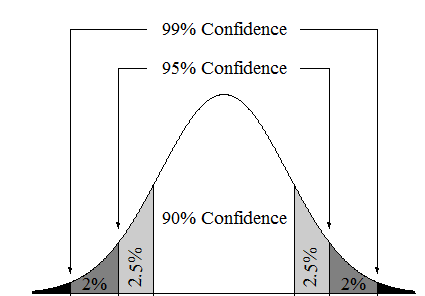
A bit more complicated, but you get the idea. Regardless, we have a successful survey. That said, I am not a professional market research person. This survey isn't perfect. It was never meant to be perfect. It was simply meant to provide more data points to look at.
The main issue is I do not know if the survey respondents represent the 2026 Citrus County voters. It could be skewed a bit. For instance, I am going to assume the Chamber survey is skewed towards those who have favorable views of the Chamber. I am going to assume that my survey is skewed the other way and likely includes more people who do not have a favorable view of the Chamber. The real voting public is somewhere in the middle.
But again, more data is the goal and this satisfies that.
Ok, enough rambling.. Let's dive in.
For this survey, I am using 95% confidence level with 6% margin of error because that will give assurance that the population is within the interval... meaning the correct data.. at the sacrifice of 1% point of accuracy.
Question 1:
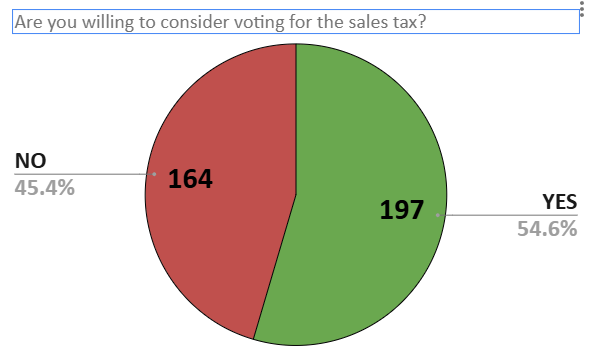
Remember, the Chamber had this at 60% or so in support. So results are similar. There is support for a sales tax.
Note... The rest of these answers ONLY ask those people who said they would support it. If someone said "no", they have a chance to be convinced (more later), but I did not want them to skew the results of the other questions. I only asked the 197 who said they would support it.
Also, not every answer here on out has 197 responses. Some people did not answer every question.
Question 2:
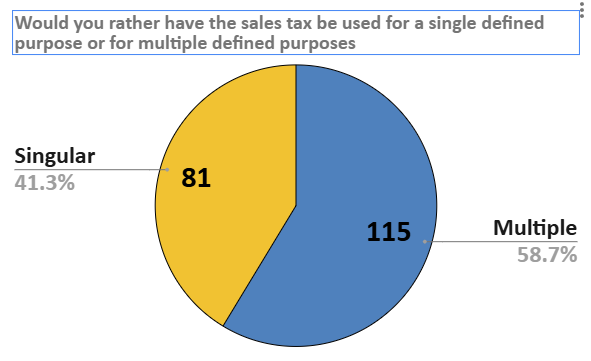
Question 3:
This question was only asked to the 81 who answered a singular use to Question 2
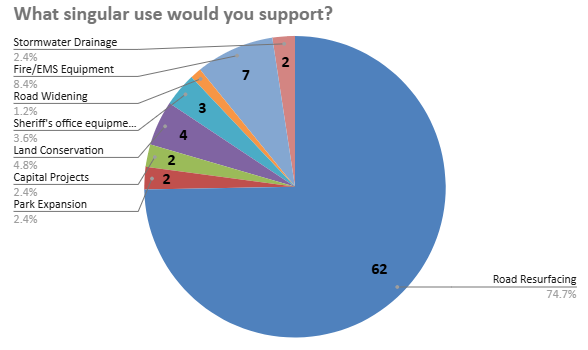
Question 4:
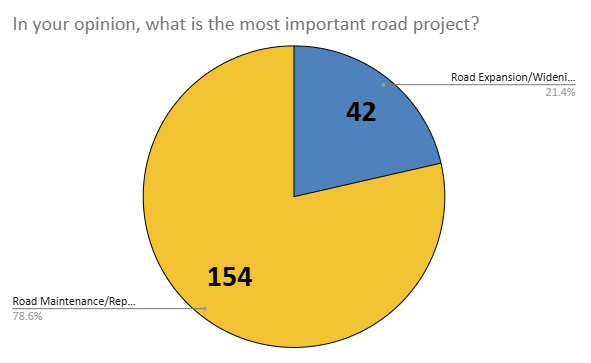
Question 5:

Question 6:
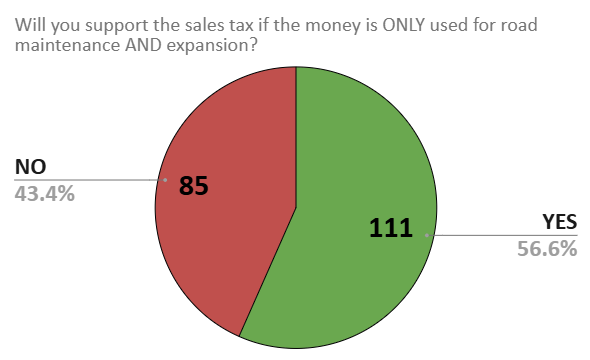
Question 7:
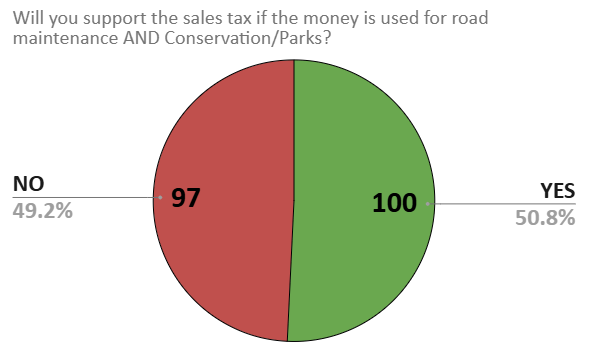
Question 8:
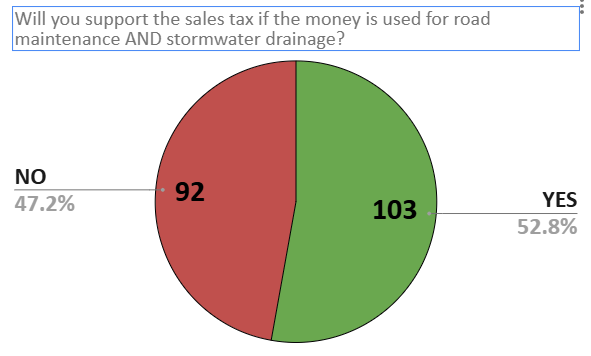
Question 9:
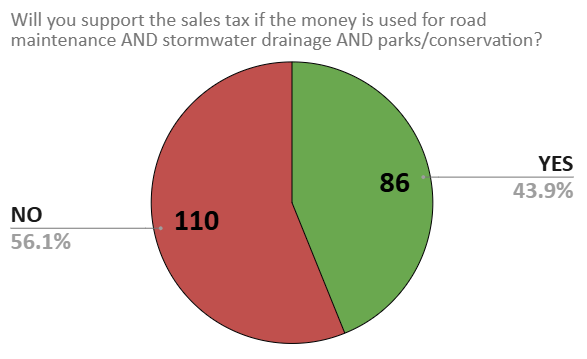
Question 10:
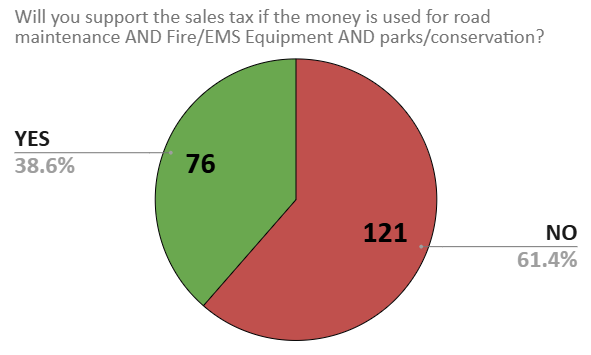
Question 11:
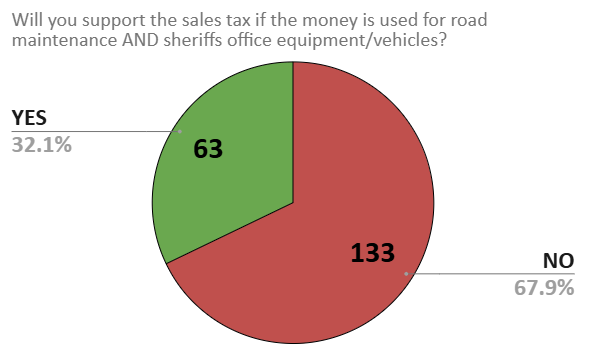
Question 12:
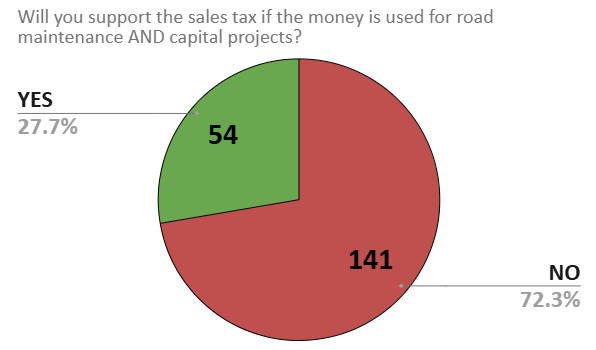
Question 13:
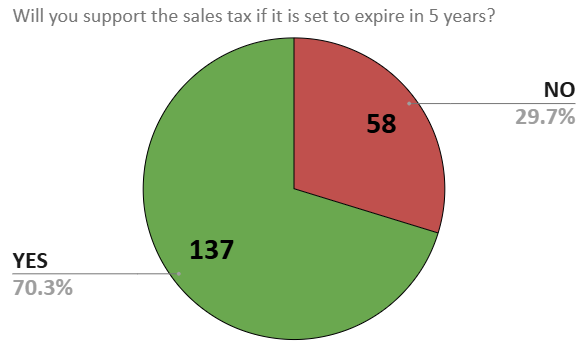
Question 14:
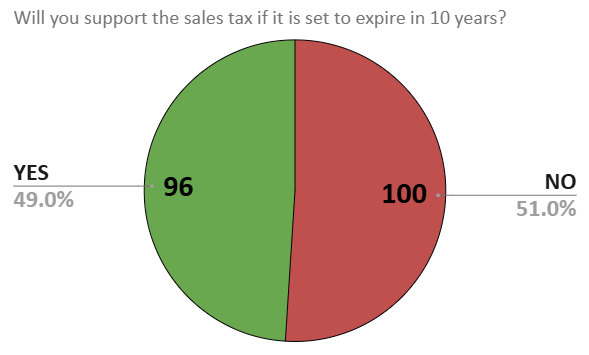
Question 15:
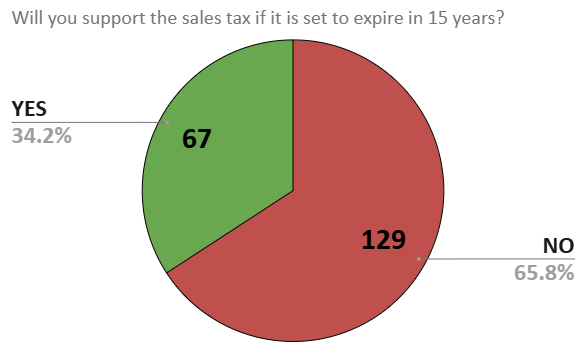
Question 16:
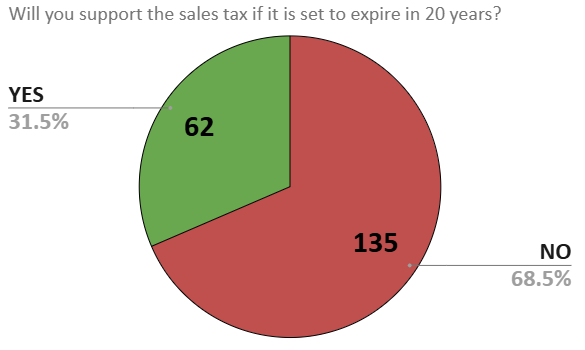
Question 17:
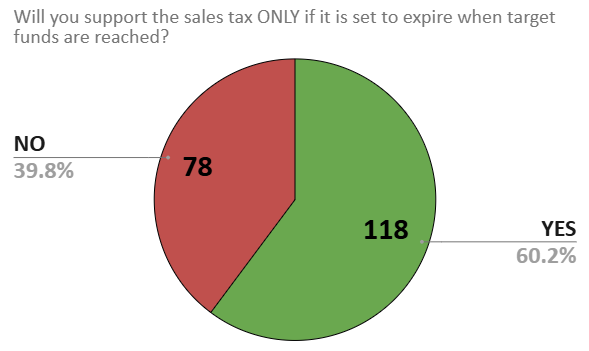
Question 18: This question asks if people would support the sales tax if gas tax was kept the same it is today or if they require a reduction in gas tax... not sure if it is even possible to change the gas tax, but I wanted to ask the question.
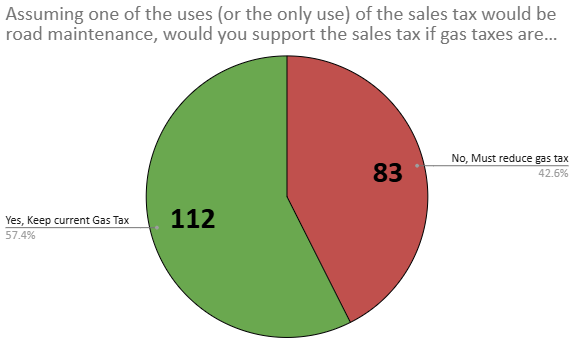
Question 19: This question asks people that assuming roads are selected as a purpose of the tax and it is implemented, if they feel that millage needs to stay the same to get roads done quicker (yellow), if they want to see a bit of millage come off (blue) or if they want to see millage removed to offset the sales tax (cream)
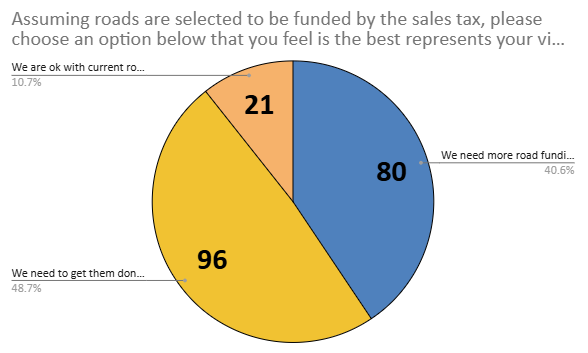
Question 20:
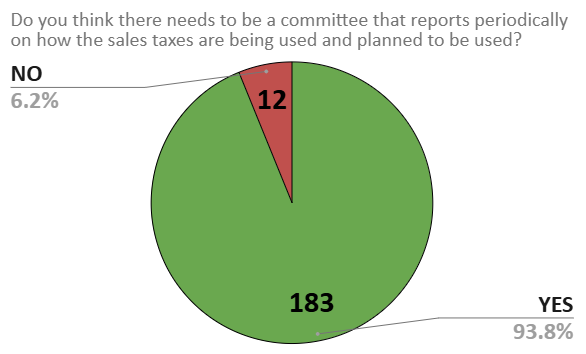
These questions were ONLY asked to those who answered that they would vote "NO" on the sales tax.
Question 21:
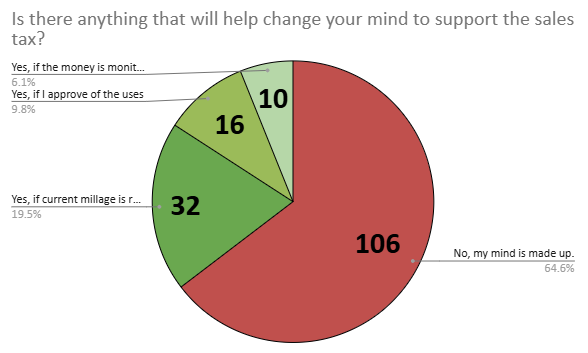
Question 22: Only asked to those who answered "YES, if I approve of the uses" on the previous question.
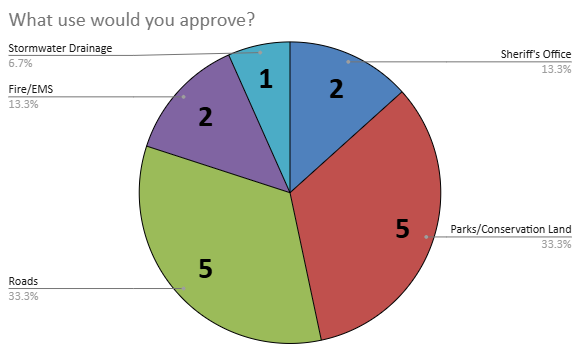
Ok... Observations...
1) It is clear there is support in the community to implement the sales tax, but what is the actual support? The Chamber Survey showed 59.1% support. Factoring in the margin of error for their survey at 5%, it clears the threshold to pass of 50% plus one vote.
This survey shows 54.6% support with a 6% margin of error. That can go either direction. However, you factor in the 58 people who said "NO" but then said they could change to a "YES" if certain things are met, that brings the total of "YES" votes to 255, which is a 70.64% support. That easily clears the margin of error. This is likely the 12.6% of the undecideds from the Chamber survey.
So it would appear there is plenty of support to pass this, assuming certain conditions are met.
2) People want roads done with this money. That is clear. Both surveys showed that. However, does it need to be 100% focused on catching up on our resurfacing and maintenance or does it need to be focused on expansion of roads like 491?
According to this survey, it would appear most want to focus on resurfacing. That tracks with what people have told me in discussions... "Focus on resurfacing and let impact fees go towards expansion". The idea there is that new growth pays for new roads and sales tax goes towards maintenance of what we have.
3) Most people support a variety of uses. We saw this from the Chamber survey. I wanted to know what specific combinations people would support. From the data, road resurfacing and road expansion combined uses would pass outside the margin of error. That is it. Everything else falls within the margin of error or fails.
One interesting observation. Stormwater drainage has more support in this survey than conservation and parks for uses combined with road maintenance. Both will pass (barely), but within margin of error.
This solidifies the idea that people want their roads done. Makes sense because we hear that the most.
But again, this poll is NOT guaranteed to be accurate, which goes to my point later that we need more data.
4) Duration. This was one of the main things I wanted to see.. How long should this sales tax last and what will people support? The Chamber showed the most people supported 10 years. This survey shows 10 years fails (within margin of error). So which is it?
People largely support 5 years, every other duration fails. However, one thing stands out... a set amount.
For instance, if the BOCC says we need $100m and sets that as the goal of the sales tax, people will support that. It then goes away after $100m is reached. It is a number written in stone so to speak. People can see how quickly it is coming. There is then an option after it ends to bring it back via another vote.
This might be the best option... so keep an eye on it.
5) Bonding. The 10+ year options allow bonding, so the county can borrow money now to do road projects (assuming that is the use) at a cheaper rate than it will be in future years. This helps get stuff done... however, it requires 10+ year durations. I am not sure if the set amount allows bonding or not.
However, this only applies if people want road expansion. I am not sure if resurfacing can be bonded... if so... interesting conversation there... but largely it has been talked about to bond expansion projects like 491.
6) It appears there is support for taxes to remain as they are, without reducing millage or gas taxes. I doubt after a tax "increase" this year that the BOCC will keep taxes as they are if the sales tax passes. I assume they will want to reduce millage for road resurfacing for example. But data suggests there is support to keep current levels because people want to get stuff done.
7) The committee thing is an interesting one. I asked that question because it popped up on the Chamber's survey responses and the BOCC talked a bit about it. Not exactly sure what this would look like, but I imagine a volunteer board of citizens that make a report on how the money was spent during the previous period (month, quarter, etc).
I suppose staff could do this, but it appears people want citizen involvement to "monitor" the funds. The sales tax can ONLY be used for the purposes that are stated, so not exactly sure what they would be monitoring, but a report of some sort helps with transparency and can show people "This is what we accomplished this term".
8) It is interesting that people would answer "NO" they would not vote for it, but then come back and say they would if certain conditions are met. I believe this shows the lack of information around the sales tax. That information is out there and the Chamber did a good job of supplying it, but I imagine people missed it or just didnt pay attention.
In any case, 58 people is close to half of the "NO" voters that could be swayed. Most of those would support it with millage reduction (see point 6) or monitored (point 7).
So what does all this show? The need for more information. How are commissioners supposed to decide on Tuesday what to put into this? If they choose the wrong things to use it on or if they choose the wrong duration, the data suggests that it fails.
If the goal is to get community input and do what the community wants and NOT what the BOCC wants, then we need more community involvement. That requires more conversation. They dont need to be deciding this in October when we have until April. Let's have more conversation.
But how? That brings me to the North Florida Land Trust. A few weeks ago, it was brought up by Commissioner Davis. You can read about it here.
Basically NFLT are experts in voter referendums. Projects they accept have a 85% success rate. Why is that? Because they do the community research to find out exactly what the community wants and desires.
Sounds great, how much?
Well that is the great thing. They dont cost tax payers a dime. Their fees are paid for via private donations to a PAC that they are associated with. So if the BOCC decides we need some outside help, it will come at zero cost to tax payers. If the fees arent raised by donations, they dont do the work and we are back where we are now.
Cool... let's go.
Not so fast. Part of their requirements is that money go towards conservation efforts. So if they are to do this, a portion of the sales tax has to be used by Citrus County on conservation efforts and things like parks.
To find out if the community will support that, they do all the research. They engage with the community and get their feedback. Then make a presentation to the board showing exactly what the community wants.
So basically another survey, but one done that is scientifically sound and data driven... much more in-depth than what I or the Chamber did. But for them to go further with it and continue the effort, the community will have to show that they support conservation efforts.
I believe that the data suggests they do.
So that would be my suggestion to the board. Tap the brakes a bit on this. Let the NFLT come in and do their thing at ZERO cost to taxpayers. Let them present their data to the BOCC... and since that data will be given to them by the community, the BOCC then should accept their suggestions... at which point, they continue the process (assuming its supported and conservation is included) and they continue to educate the community throughout the process.
If the BOCC sincerely wants this to be a community effort, this is how you do it. Let the experts work with the community and get exactly what the community wants.
We shall see come Tuesday what they decide.
